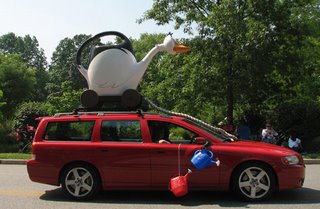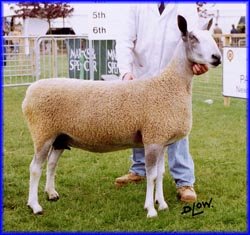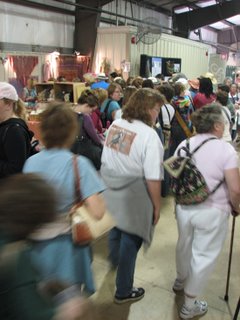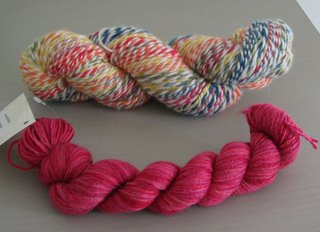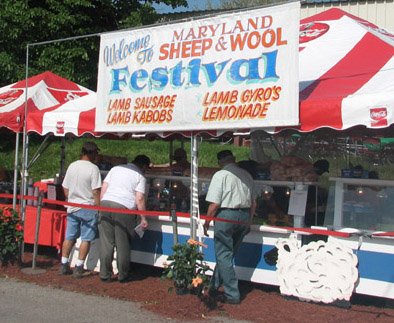A reader asked if I would talk about knitting needles. At first, I wasn't quite sure what there was to say on the subject, but once I thought about it a little while, I was able to come up with something. Let me know if this hits the spot, those of you with needle-related questions.
Applying the analytical approach that so many of you have apparently come to know and love (shucks), it seems to me there are two aspects of needles to talk about. The first is the form of needle: straight, double-pointed, or circular. The second is what they're made of: wood, metal, plastic or something else. But either way, the most important thing about needles is what YOU like.
StructureWhen you mention knitting needles to the uninitiated, the most common image is that of straight needles: two sticks, each with one pointy end and one end with a stopper of some kind. You can knit most things on straight needles. You knit back and forth, turning the work at the end of a row. The stitches start out on the needle you hold in your left hand, and as you manipulate them, end up on the needle in your right hand; then you turn the work, put it in the left hand, and start again. Because you're working back and forth (imagine a piece of paper), you have a right side (meaning the side that will face out when you wear it) and a wrong side (the side the will go next to your skin and not be seen).
Circular needles and double-pointed needles basically do the same thing: they allow you to knit in a circle instead of back-and-forth in a straight line. Actually, they allow you to knit spirally; imagine the cardboard tube inside the paper towel roll and the way the cardboard spirals around, and you'll have the best vision of how knitting "circularly" works.* You, clever ones, immediately see the advantages: knitting a tube allows you to make things like hats and socks and sleeves without sewing a seam. There are some knitters who firmly believe that since the human body is made up of rounded pieces, like arms and torsos, that garments knit in the round will fit better than garments knit flat and pieced together. But even the most industrious knitter has to acknowledge the beauty of avoiding seam sewing; not only is it faster, but you avoid the ridge that even the most skillfully-sewn seam will produce.
The second advantage is that you are always working the right side of the knitting. If you want to make a hat in stockinette stitch, and you are using straight needles, not only will you have to sew the seam to form the tube, you will also have to knit across the right side and purl back across the wrong side. However, if you are knitting circularly, you will only have to knit; you need never purl to produce stockinette stitch. Purling tends to be a little less intuitive a motion for most people and slower, so many knitters like to eliminate purling as much as possible. If you have inconsistencies in the way you knit, you may find your knit rows are snugger and a slightly tighter gauge than your purl rows, and knitting stockinette stitch circularly eliminates this. [Conversely, to get garter stitch while knitting circularly, you must knit a row then purl a row. But most knitters use stockinette more frequently than garter stitch anyway.] There is an excellent minitutorial on how to convert back-and-forth/straight needle patterns to knitting circularly in one of the Barbara Walker treasuries, in the introductory material. Worth a look.
Knitting circularly is one of those things that just amazes me with its cleverness and ingenuity. If you try to knit in the round with two straight needles, you quickly see how trying to fashion a tube out of two parallel straight lines ain't gonna work.
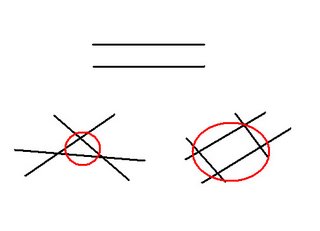
Double-pointed needles add one or two sides, turning parallel lines into a triangle or square. (Some people knit with 4 dpns, others with 5.) You divide up the stitches amongst your 3 (or 4) dpns, setting one aside to be the working needle. Then you work around the tube by knitting the stitches from one of the legs of the triangle (square) onto the working needle; the working needle becomes a leg of the triangle (square) and you use the newly-empty needle as working needle, on and on, around and around.
Now if you're me, for I'm not terribly adept at dpns, you forget to keep incorporating the newly-empty needle, absent-mindedly dropping it to the floor or in your lap, and pretty quickly you end up with all your stitches, twisted and gasping on two dpns. Pretty easy to fix: just redivide the stitches among 3 (4) dpns and continue.
Dpns have the advantage of being excellent for small circumferences: skinny tubes like sleeve cuffs or preemie hats or socks. They are not so great for large circumferences; while dpns come in various lengths, unless you live in the Shetland Islands, it isn't so easy to find really long ones, so if you're trying to knit a wide tube, you're out of luck unless you keep adding more and more sets, which would get ridiculous fast, especially considering how much circular needles have developed.
Circular needles are all one piece and consist of two pointy needles, a couple of inches long, connected by a cable. The size of the pointy sticks varies just like straight needles and the length of the cable varies, too. That's why you describe circular needles as "size 8 (US) circulars with a 16-inch cable." They're more intuitive to work with: you can see the circle shape right away, and you just keep on going around and around and around, without worrying about incorporating a working needle. It helps greatly to put a marker of some sort at the end/beginning of each round so you know where you've started.
Circular needles have the opposite advantage of dpns: they are good for knitting big wide tubes, but poop out when knitting skinny ones. Most knitters believe that a 16-inch circular needle -- which will knit, roughly, 16 to 24-odd inch circumferences, and if you stretch the stitches a little, you might be able to create a 14- or 15-inch circumference -- is about the smallest size cable one can work comfortably. They do make circular needles with a 12-inch cable, but they are painful to work with. Unless you have hands of steel, you'll probably agree that working more than a few rounds on a 12-inch circular is a one-way ticket to carpal tunnel. Which means that if you want to knit smaller tubes, you have to either switch to dpns or add in a second circular (more on this later). Circulars are great at knitting large circumferences, though; get yourself a long cable -- maybe 40-inch -- and you could knit a very wide tube (how about a knitted sleeping bag?).
The other advantage of circulars is that they help distribute a large number of stitches over a wide cable, making it easier and more comfortable to knit big projects like afghans. Instead of trying to shove 450 stitches onto one 14-inch straight needle and then holding it in your left hand, you can distribute them out over a 36-inch cable and hold only some of them on the needles. Easier on your hands to hold, easier to balance on your lap.
You can knit back-and-forth on either dpns or circulars if you like. With dpns, you just have to be aware that both ends of the needles are pointy, so if you have a lot of stitches they may slide off one end. If you get stuck without one straight needle, you can put a point protector or some other stopper on one end of a dpn and use it like a straight needle. You can knit back and forth on a circular needle, too, basically by pretending the cable isn't there; just turn it at the end of a row like you'd turn straight needles. This is one of those questions that seems to baffle newly-minted knitters; they don't see right away that it's possible to knit back-and-forth on circular needles.
*The fact that you are never completing the circle, but rather working spirally, is why you get a blip when switching colors to knit stripes in the round. This is commonly known as a "jog" and there are various techniques which are supposedly enable you to camouflage it. Google it.MaterialsNeedles come in all different substances, plain and fancy. There are wood needles (all kinds of wood, too, from bamboo to ebony to rosewood); plastic needles; metal needles; casein needles; and so on. Conventional wisdom attributes certain characteristics to certain kinds of needles. Addi Turbos are plated with nickel to make them very slick and fast. Some beginners find they are too slippery to be comfortable; knitters with a need for speed swear by them as the fastest (maybe Lily Chin, a.k.a. World's Fastest Knitter, will leave a comment giving us her expert opinion on the issue?). Bamboo and other wood needles are reputed to be somewhat slower, the theory being that the fiber sticks a little to the wood or meets a bit of resistance. Plastic is light and middle of the road when it comes to speed. Casein (made of milk protein) has a feel all its own. Regular Inox needles have a Teflon coating that I find is moderate: not too fast, not too sticky. Over time, you may develop strong preferences or you may be one of those knitters who doesn't notice or care.
And this brings me to the critical thing to consider in needles: what you like. There's nothing inherently better about one kind over another so long as it works for you. Try a bunch of kinds out and see what you like.
One thing to consider when looking at needles is how sharp the tip is. Some needle tips are blunter than others. If you knit a lot of lace, or anything involving a lot of decreases, it helps to have a tapered tip to slip under stitches more easily. I've heard the Bryspun needles are good for this. Sometimes wood needles can get worn down at the tip or develop splinters; you can try sandpaper to smooth them out.
Another important consideration is what the cable is made of (plastic can kink if it's not good quality) and how smooth the join -- where the needle ends are joined to the cable -- is. If you are doing something involving a lot of sliding back and forth over the join, like knitting I-cord (if you don't know what that is, Google it), you will find a big difference between Addi Turbos (the smoothest join, IMHO) and cheaper brands; rough joins can catch your yarn or tug on the stitches and make it harder to slide them, substantially raising the aggravation factor.
Fancy stuffAll kind of artisan-like needles are coming on to the market. You can buy very serviceable needles made of plastic or bamboo for under five bucks; if you've got cash to burn, you can splurge on gorgeous
Lantern Moon needles in various fancy woods with different shaped tips, for around twenty bucks a pair. One of my favorite needles are a wooden pair I got at a long-ago Stitches; they were made by Peace Fleece and have red painted balls on the end. I've even seen articles about
knitting needles that light up so you can knit while you're in the movies. (Nope, I'm not making that up.)
One of the best developments in needle technology is the improvement in the quality of circular needles. Year ago, circular needles were pretty crappy; the cables tended to kink up and get permanent bends in them (you sometimes hear knitters talking about soaking the cables in hot water to smooth out the kinks) and the joins were rough. But with the invention of the Addi Turbo -- with metal cables and super-smooth joins -- circular needles entered a new era. Consequently, enterprising knitters came up with more ways to use the circulars. The most popular is the two-circular needle method, sometimes called the "Socks Soar" method after the booklet
"Socks Soar on Circular Needles" by Cat Bordhi. (However, purists will note that this method was described in Interweave Knits before "Socks Soar," and as one might expect with a craft as old as knitting, skills tend to be rediscovered rather than invented.) A tutorial on knitting with two circulars is way beyond what I can do for you, but there are excellent ones out there. The gist of it is dividing your stitches in half, and putting half on one circular needle and half on the other; you then work the needles in turn as you go around. This allows you to do very small circumferences without switching to dpns.
Another popular method is called "the Magic Loop," after a booklet by Bev Galeskas and Sarah Hauschka, and involves using a circular with a really long cable, then pulling a big loop of cable through periodically as you work around. Again, Google this and you'll find tutorials. And again, this is designed to let you work small circumferences, ones that are smaller than the length of your cable, without switching over to dpns. As someone who is a tremendous spazz with dpns, I have benefited greatly from these alternative methods for knitting circularly.
Finally, it is worth mentioning the sets of interchangeable needles, like the
Denise sets. The needles and cables are, as the name suggests, interchangeable; you can unscrew the needle tips from the cable. You can screw different sized tips onto different length cables, and thus if you carry the little case around with you, you'll always have the right sized needle. I have friends who swear by these; I've never found them appealing. To each his or her own.
And please...don't fill up the Comments section with testimonials as to how you prefer one method over another. No one here cares which one you use, so long as you use it happily and well. And we're not going to get into a "I use only double-points" snobbery thing, either. Use what works and what you like, and don't waste any time patting yourself on the back about it.




